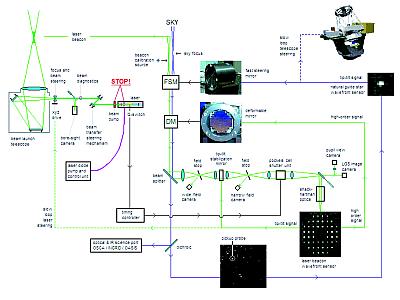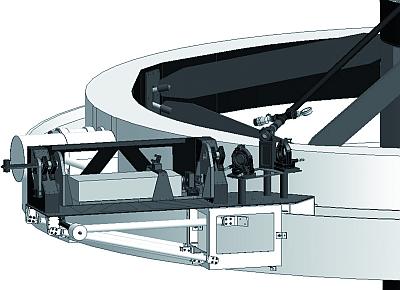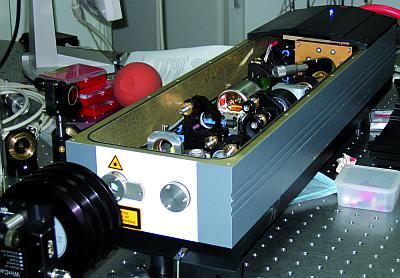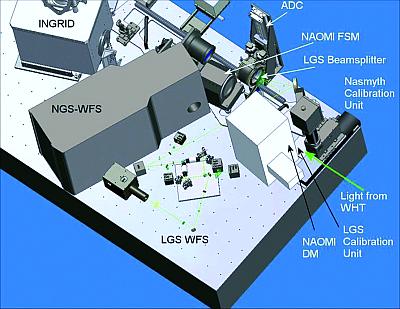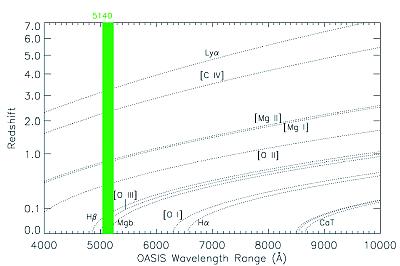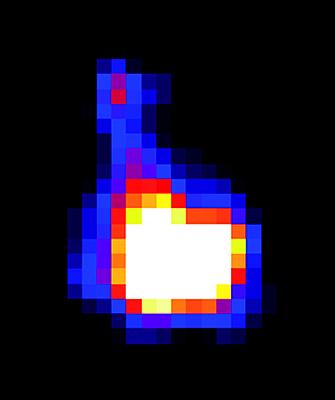 | |||
|
| Home > Public Information > ING Newsletter > No. 10, December 2005 > Progress on the GLAS Rayleigh Laser Beacon System for the William Herschel Telescope |
|
|
SCIENCE |
|
|
|
Previous: The SAURON View of the Nuclear Ring in M100 | Up: Table of Contents | Next: CIRPASS on the William Herschel Telescope: Measuring the Global Star Formation Rate Over Most of History
Article mirrored at: La Palma server | Cambridge server
Other available formats: PDF
Progress on the GLAS Rayleigh Laser Beacon System for the William Herschel Telescope
René G. M. Rutten* (ING) and Gordon Talbot (ING)
Adaptive Optics (AO) has been central to the development strategy of the WHT. The generally good seeing conditions make the site very attractive for AO exploitation and has the potential to offer major new advantages for astronomy. The higher spatial resolution achieved through AO has the obvious advantage of distinguishing finer structure and avoiding source confusion in dense fields.
Existing AO instrumentation at the WHT, NAOMI, is located in a purpose built enclosure occupying one of the Nasmyth foci. Science instruments include a 1024 by 1024 pixel HgCdTl infra-red camera, INGRID, an optical integral field spectrograph, OASIS, and a coronagraph unit, OSCA. In particular the OASIS spectrograph offers unique capability, and for that reason the focus of AO science exploitation lies in the wavelength range of 0.6 to 1.0 micron.
Although natural guide star operation of the NAOMI AO system is now well established, the limited sky coverage for higher order AO operation has proven a serious limiting factor in its science use. For that reason in 2004 a project was embarked upon to develop a facility class general purpose Rayleigh laser beacon system. The project acronym, GLAS, stands for Ground-layer Laser Adaptive optics System. The overall scientific aim of the GLAS project is to drastically improve the sky coverage for high-order AO. In order to provide the enhanced scientific capability on the shortest possible timescale, the GLAS system will be kept relatively simple and use existing commercial laser technology, without compromising the quality of engineering or safety aspects.
GLAS is a project led by ING, in collaboration with groups at the University of Durham, Leiden Observatory, the ASTRON institute, and the IAC. Without the enthusiastic collaboration of many people at these institutes, GLAS would no be feasible. The project was made possible through a grant from the Netherlands Organisation for Scientific Research, NWO. This paper gives a brief overview of the status of the project.
The practical challenge of GLAS is to project a bright laser beam to an altitude of 20km above the observatory, bringing it to a sharp focus, and use the Rayleigh back scattered return signal for sensing atmospheric turbulence. To implement a Rayleigh laser beacon system with the existing AO instrumentation suite three main components have to be built in addition to the existing AO system:
- A laser unit and laser beam relay system leading the laser light to behind the WHT secondary mirror.
- A beam projection telescope that will be mounted behind the secondary mirror.
- A laser beacon wavefront sensor system.
Real-time control software and user interface software must pull the components together into a working system. Much attention will also be paid to safety aspects and to avoid the laser light from interfering with other telescopes at the observatory.
A top-level system overview of the full AO and laser system, with the main interactions and feedback loops indicated, is shown in Figure 1.
The laser unit will be located at the top of the WHT in a temperature controlled and gravitationally stabilised unit (see Figure 2). The laser beam, once directed to the beam launch telescope behind the WHT secondary mirror, will be expanded to 35cm and leave the dome, to be focussed to a spot about 10cm wide at a distance of 20km.
| Figure 2. Engineering drawing of the laser cradle, attached to the top ring of the WHT. The laser beam will pass from this cradle to the projection telescope behind the secondary mirror through an evacuated pipe. The full light path will be enclosed for safety reasons and to reduce light and thermal polution. [ JPEG | TIFF ] |
| Figure 3. The GLAS laser unit. [ JPEG | TIFF ] |
| Figure 4. Laser wavefront sensor on the NAOMI optical bench layout. [ JPEG | TIFF ] |
The choice of laser wavelength is defined primarily by availability of suitable solid-state lasers. The ability to provide a small spot in the sky is intimately linked to the laser beam quality. In particular the output beam should have a stable, uniform, Gaussian intensity profile. Combining beam quality with high power output is only found in few commercially available lasers (within the cost envelope allowed by the GLAS project). For GLAS a pulsed Yb:YAG laser has been sourced that delivers a rather unique combination of high power output and excellent beam quality. This so called disk laser employs novel techniques for laser pumping and temperature stability of the lasing medium that is essential in delivering the beam quality and power. Its bright 400ns pulses running at 5000Hz will carry a total output power of 30W at a wavelength of 515nm.
Rayleigh back scattered laser light seen by the WHT and entering the Nasmyth focus is picked up by a 15nm narrow band notch filter. This filter is the only additional optical component in the science beam when observing in laser guide star mode. Of course the spectral band in the immediate vicinity of the laser wavelength cannot be exploited for science observations (see Figure 5). But as the scientific advantages for AO exploitation fall primarily at longer wavelengths this limitation is not considered critical. Moreover, GLAS will be engineered in such a way that AO operation without the laser will still be possible.
| Figure 5. Diagram showing the impact of the laser notch filter on important spectral lines as a function of redshift. [ JPEG | TIFF ] |
The back scattered laser light will return from the whole of the atmosphere. In order to produce a tight spot for the purpose of wavefront sensing a fast shuttering system is used that will admit back scattered light to enter a very brief period after the laser pulse went out. That way only light returning from a certain distance in the atmosphere set by the light travel time, will enter the wavefront sensor. The shutter will be based on Pockels cells, whose open and closed state will be set by a fast timer unit that will provide a time delay of some 130ms between the laser pulse leaving the dome, and the backscattered light returning from 20km. The resulting brightness of the laser beacon equates to a star of about 9.5mag.
Once having traversed the shutter light will enter a standard Shack-Hartmann wavefront sensor with 8×8 elements sampling the telescope pupil, using a standard high speed CCD detector. The signals from this wavefront sensor will be fed back to the deformable mirror at a rate of about 300Hz.
A laser guide star AO system still requires a natural guide star for sensing the tip-tilt component of atmospheric turbulence. Since the laser light passes essentially the same atmospheric turbulence on the upward and downward pass, the return beam does not carry accurate information of the wavefront tilt induced by the atmosphere as starlight from infinity would experience. The availability of such natural tip-tilt stars still poses a limiting factor on sky coverage. But this limitation is much reduced from the case of normal AO as the star can be much fainter and is allowed to be much further away from the science object. Also if the science object itself is bright enough to serve as tilt reference source then of course a separate star will not be required. The GLAS system will accommodate moderately extended sources such as galaxy cores for this purpose.
The resulting sky coverage will depend primarily on the chance to find a bright enough star for tip-tilt sensing. Under nominal operating conditions a star as faint as R=18 should suffice for closed loop tip-tilt sensing at 100Hz. As for such faint signals detector read noise poses an important limiting factor, we have opted for a low light level CCD which through on-chip signal amplification achieves sub-electron read noise. The unvignetted search field is 2 arcmin. While in the case of natural guide star AO sky coverage is of order one percent or less, the GLAS system will give nearly 100% sky coverage up to a galactic latitude of 40º, tailing off to 50% coverage at the Galactic Pole. Note that the exact values will depend on the passband used for OASIS observations, as OASIS competes with the tip-tilt sensor for the visible wave band, and on the exposure time for tip-tilt sensing.
The AO correction that will be achieved will be moderate in terms of Strehl ratio, but scientifically very attractive in terms of improved FWHM.
Extensive modelling has been carried out to understand the anticipated system performance. Table 1 gives a few of the key results from model calculations based on a laser beacon at an altitude of 20km and a natural tip-tilt star of R=17. The model includes representations of the atmosphere, telescope, laser guide star and the AO sub-systems. Performance predictions were calculated using end-to-end Monte-Carlo simulation software developed by Richard Wilson (Durham University).
|
||||||||||||||||||||||||||||||||||||||||||||||||||||||||||||
| Table 1. GLAS performance expectations. FWHM in arcseconds for different values of r0 and wavebands. | ||||||||||||||||||||||||||||||||||||||||||||||||||||||||||||
The results summarised in Table 1 reflect a realistic range of seeing conditions on La Palma where median seeing is 0.69arcsec. Calculations were done for the atmospheric turbulence (“Fried-”) parameter r0 values of 0.11m, 0.14m and 0.19m, specified at 500nm, corresponding to natural seeing at 550nm of 0.90arcsec, 0.69arcsec and 0.50arcsec respectively. Image FWHM were assessed at four wavebands: R (650nm), I (850nm), J (1250nm), and H (1650nm). Table 1 presents the FWHM values for the various combinations of r0 and filter, for the case of a natural guide star on-axis, and 1arcmin off-axis, covering the full range of operation. It should be noted that the results are based on statistical analysis and are therefore not exact. For reference, λ/D as a measure of the diffraction limit is shown as well.
In summary, the on-axis models predict near diffraction limited performance in the J and H bands for good seeing conditions. At shorter wavelengths the diffraction limit will not be reached, but there will be a very attractive improvement in the delivered point spread function. It should be noted that any source as faint as R=17, and possibly even fainter, may serve as a self-referencing tip-tilt source. Hence for any such point source good AO correction will be obtained. For fainter science targets or diffuse sources an off-axis natural guide star is required, causing some degradation of AO performance.
Over the typical OASIS field of view the PSF uniformity will be excellent. For the INGRID IR camera, with its 40arcsec field of view, however, there will be a noticeable field dependence from centre to edge of about 15% in FWHM.
How realistic these performance predictions are is maybe best underlined by Figure 6, showing a NAOMI+OASIS I-band exposure of a close 0.22arcsec binary. During excellent seeing, a FWHM of 0.1arcsec was obtained.
| Figure 6. AO corrected I-band image of a bright 0.22arcsec binary obtained with OASIS and NAOMI during excellent seeing conditions. [ JPEG | TIFF ] |
Based on the La Palma seeing statistics we anticipate that suitable seeing conditions for general AO and laser beacon operation will exist about 75% of the available observing time. Periods for which ground layer turbulence dominates, and hence will be especially suitable for GLAS, occur about 25% of the time.
If all goes well, by the end of 2006 the GLAS laser system should be up-and-running. It will drastically improve sky coverage and thus boost the science use of adaptive optics. AO performance will provide attractive image quality improvement at visible wavelengths and close to diffraction limited performance in the infra-red. The GLAS laser beacon will therefore be crucial in opening new avenues for spectroscopic surveys at spatial resolutions that are considerably better than offered under natural seeing conditions.
Last but not least, the work on GLAS to date has been the effort of many people, including from the participating institutes: Don Carlos Abrams, Nikolaos Apostolakos, Richard Bassom, Chris Benn, Maarten Blanken, Diego Cano, Alan Chopping, Kevin Dee, Nigel Dipper, Eddy Elswijk, David González, Tom Gregory, Rik ter Horst, Ron Humpfreys, Jan Idserda, Paul Jolley, Sjouke Kuindersma, Juan Martínez, Richard McDermid, Tim Morris, Richard Myers, Sergio Picó, Renee Pit, Johan Pragt, Simon Rees, Jürg Rey, Servando Rodríguez, Ton Schoenmaker, Jure Skvarc, Remko Stuik, Niels Tromp, Simon Tulloch, Auke Veninga, Richard Wilson (and now just hope we have not forgotten anyone!). ¤
*: Email contact: René Rutten (
 )
)
| Top | Back |
|

